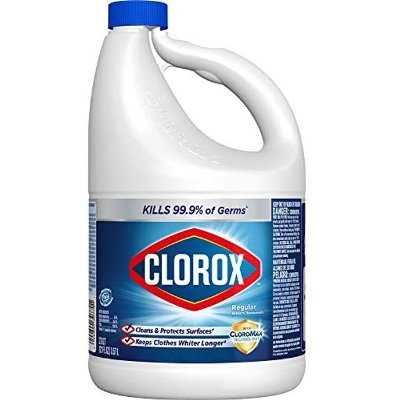Wood floors are a durable and beautiful asset to your home because of its richness, warmth, and resale value. However, your laminate flooring is susceptible to stains and may be difficult to reduce and eliminate. Besides, woods also create cracks if they are absorbent.
Cleaning your parquet floors without fading and breaking their structure is an important issue. Can you bleach hardwood floors? What happens when you use detergent to clean your laminate flooring? Do not worry! This article will help you answer all of your questions. Check it now!

Table of Contents
Can You Bleach Hardwood Floors?
The answer to this question is yes, but bleaches are not the ideal and safe solution for your wood floors because of its strong oxidizing properties. The bleach can penetrate the porous fibers, disrupt the wood’s finish, weaken and discolor the floorboard’s structure.
Therefore, if not absolutely necessary, you should use a cleaning solution that acts as bleach without affecting your wood floors. In case you have to use bleach to clean the wood floors, be careful not to use concentrated bleach but dilute with water in a certain proportion.
We insist once again, we do not recommend using bleach to clean your wooden floors, and in certain cases, you must dilute them with water.
Wood’s hardness and durability is a key factor in determining how bleach will affect your floors. The harder and durable woods, the harder it is for bleach to penetrate deep inside. In addition, the woodworking process also affects the bleach’s penetration ability.
The more carefully machined and processed your laminate floor is, the harder it is for bleach to permeate inside. However, asking yourself if it’s worth the risk before using it.
Besides bleaches, it would be best if you never use a mop with hot water or even steam cleaner or steam on your laminate flooring similar to bleach. Steam can damage your floor because it can penetrate the voids of the wood.
What Is Kind Of Bleach Suitable For Wooden Floors?

<Via www.walmart.com>
There are currently three popular bleaches on the market: Two-part bleach, chlorine bleach, and oxalic acid. Let’s take a look at their active ingredients to determine which bleach is less dangerous for your wood floors when using.
Chlorine Bleach
Chlorine bleach is the most common detergent, releasing chlorine radicals and oxygen radicals, making molecules formed of one oxygen and one chlorine atom. It is best for removing problem stains and dyes.
Two-part Bleach
Two ingredients mentioned in this type of bleach are hydrogen peroxide và sodium hydroxide. These ingredients combine to remove the stain; at the same time, they can also fade your wood floor’s color.
Oxalic Acid
Compared with other bleaches, oxalic acid has weak reducing properties, but it is useful for cleaning stains.
Two-part bleach, chlorine bleach, and oxalic acid are all corrosive and can clean your wooden floors. However, these bleach types change the color of your laminate flooring by breaking the bonds of pigment cells in the woods, thereby changing how they reflect light.
Summary, if you need to disinfect your wood floors, let’s begin with oxalic – the mildest form.
How to Bleach Hardwood Floors – Step-by-Step Guide

This is a complex process that requires focus and care to ensure that your wood floors are protected and look as good as new. So let’s begin step-by-step.
Step 1: Preparation
Before you start the bleaching process, you need to ensure that your wood floors are ready for treatment. Start by cleaning the surface of the floor with a soft-bristled broom or vacuum cleaner. This will help remove any loose dirt, dust or debris that may interfere with the bleaching process.
Step 2: Choose the Right Bleaching Agent
It’s important to choose the right bleaching agent for your wood floors. Look for a bleach that’s specifically formulated for wood surfaces. Make sure to read the instructions carefully before using the bleach. You may also want to wear gloves and eye protection to avoid any skin or eye irritation.
- If you need to get rid of dye and a range of organic stains such as tea, blood, juices made from berries, or other food stains, Chlorine bleach is your best bet.
- Oxalic acid is a mild yet effective choice.
- For the most persistent wood floor stains, the go-to solution is a two-part bleach kit.
Step 3: Dilute the Bleach
Once you’ve chosen the bleach, it’s time to dilute it. Follow the instructions on the package to mix the bleach with water in a bucket. Generally, bleach-to-water ratios vary between products, so make sure you’re mixing the right amount. Avoid using bleach at full strength as it may damage the wood fibers and cause discoloration.
Step 4: Apply the Bleach
Now it’s time to apply the bleach to the wood floors. Dip a clean sponge or brush into the bleach solution, and then apply it evenly to the floor surface. Make sure to work in small sections, starting from the farthest corner and moving towards the exit to avoid stepping on the wet bleach.
Step 5: Allow the Bleach to Set
Once the bleach has been applied to the entire floor, allow it to set according to the instructions on the package. This can take anywhere from 10 to 30 minutes, depending on the bleach you’re using.
Step 6: Rinse the Floor
After the bleach has set, rinse the floor with water to neutralize the bleach. Use a clean mop or sponge and plenty of water to remove any remaining bleach solution. Make sure to rinse the floor thoroughly to avoid leaving any bleach residue on the surface.
Step 7: Allow the Floor to Dry
After rinsing the floor, allow it to dry completely before applying any other treatment or sealer. This may take several hours or overnight, depending on the humidity level and air circulation in the room.
By following these steps, you’ll be able to bleach your wood floors effectively and safely!
Read also: Sticky Floors after Mopping – How To Clean Sticky Floors?
In A Nutshell
Can You Use Bleach on Hardwood Floors? Yes, but we do not recommend cleaning your wood floors with bleach. In special cases, let’s use a diluted bleach solution and pay attention to factors that affect bleach’s ability to penetrate your wood floor.
Bleach has strong oxidizing properties, and when they get inside the wood cell, destroying the wood’s structure and discolor your laminate flooring.
To avoid unnecessary problems caused by bleaches to your laminate, you can use alternative cleaning solutions, which are recommended by reputable suppliers, such as Bona, Rejuvenate, Pledge, Black diamond, Clorox, etc.

I accidentally used bleach to clean my hardwood floors. What can I do to prevent further damage?